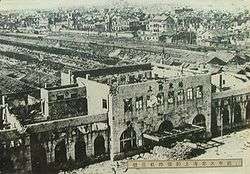Shanghai North Railway Station
_Railway_Station%2C_1908.jpg)

Shanghai North Railway Station (Chinese: 上海北站), located on East Tianmu Road, was the main railway station of Shanghai during most of the 20th century. It was closed in 1987 and a replica of the original 1909 building, erected on the same site, is now the Shanghai Railway Museum. The station tracks are still in use as a coach yard. It was also known as the "沪宁铁路上海车站" referring to the Shanghai–Nanjing Railway, of which it was one terminal.
History
The station was established as the Shanghai Railway Station in 1909 by the Qing government. It was the site of Premier Song Jiaoren's assassination by Chinese gangsters (probably working at Yuan Shikai's request) on March 20, 1913.[1][2][3] It was renamed Shanghai North Railway Station in 1916. Apart from the railway station itself, at that time the structure consisted of a British-designed four storey office building which was regarded as the symbol for the station. First destroyed in 1932 by the Japanese military during the "Shanghai Incident", the rebuilt structure was again destroyed by the Japanese in 1937 during the Battle of Shanghai. It was rebuilt again after the war and renamed back to Shanghai Railway Station in 1950.[4]
At the end of 1987, the station was closed down in favor of the new Shanghai Railway Station located on Molin Road.
Events
The Chinese republican hero, democratic activist, and founder of the Kuomintang, Song Jiaoren, was shot at the railway station on March 20, 1913, shortly after he had led the party to victory in Republican China's first parliamentary elections. Many suspected Yuan Shikai to be behind the assassination.
Shanghai Railway Museum
The Shanghai Railway Museum opened to the public in 2004, on the 55th anniversary of the Shanghai Railway Administration, at the former station. [5]The museum, in the style of a traditional building, has 1,300 square meters of outside exhibition space, and 3000 square meters in the four floors of the main buildings.[6]
On display are pictures, historical books and artefacts related to the history of constructing the Shanghai Railway and the development of railway transportation. The museum is a base for science education. About 8,000 students visited the museum to learn about the development of high speed railways.[7]
Museum exhibits include: Models of trains, CRH380A Simulation cab, Hexie type one locomotive simulator.
The museum is planned to update in 2016. The museum is going to build exhibits on the second floor, update the gift shop, and repair the Hexie type one locomotive simulator.
See also
References
- ↑ Pan Ling (1982), In Search of Old Shanghai, Joint Publishing, p. 85.
- ↑ Tang Weikang; et al. (1991), Dr Sun Yat-sen in Shanghai, Shanghai People's Art Press. (Chinese) & (English)
- ↑ Ching, Frank (2011), "Father: Legal Pioneer Qin Liankui", Ancestors: The Story of China Told through the Lives of an Extraordinary Family, London: Rider, p. 403.
- ↑ http://www.shanghai-star.com.cn/Shanghai_Delta/Shanghai_Delta_news.asp?lv1=1&lv2=3&newsid=1711&viewsid=1711&views=23
- ↑ 在上海铁路博物馆追寻辛亥革命史迹 (in Chinese). Culture.people.com.cn. 29 September 2011. Retrieved 25 September 2013. External link in
|publisher=(help) - ↑ 上海铁路博物馆 (in Chinese). Baike.baidu.com. Retrieved 25 September 2013. External link in
|publisher=(help) - ↑ 多名学生参观上海铁路博物馆 (in Chinese). zgjtb.com. 23 May 2011. Retrieved 25 September 2013. External link in
|publisher=(help)